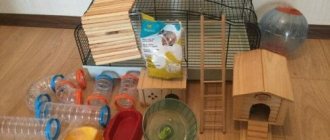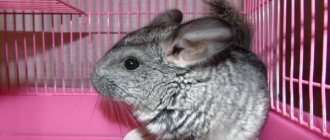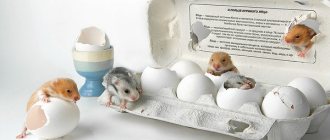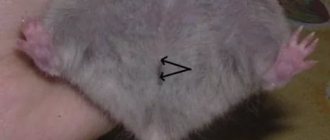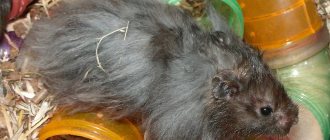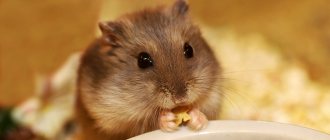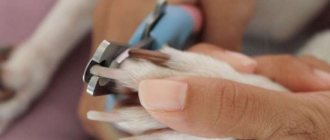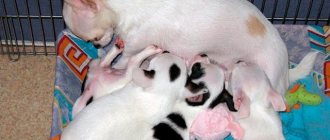- home
- Reproduction
12.04.2018
All Syrian hamsters are capable of producing offspring in captivity. Reproduction is a very responsible and important moment for those who decide to have a rodent at home. It is necessary to provide proper care and concern for the female and her offspring. The offspring that are born will grow up healthy and bring joy to you and your children. By presenting small, healthy hamsters as a gift, you will pleasantly surprise and greatly delight your friends and family. In this article we will look at preparing for breeding and caring for hamsters during and after birth.
How do Syrian hamsters reproduce?
Most hamsters reach sexual maturity at 6 weeks of age, although some can breed as early as 21 days old. It should be understood that at such an early age the offspring will be quite weak, since the animal’s body is not fully developed.
Pregnancy in young females often provokes the appearance of rickets and other complications both in her and in the offspring. Very often, females who become pregnant at the age of several weeks completely eat their offspring. Thus, it is best to mate hamsters when they reach 5-6 months of age. It should be understood that it is necessary to fit into these terms, since at a later age pregnancy can cause complications in the female.
Did you know? European hamsters are considered the largest representatives of their species. Adults reach 35 cm in length.
Experts say that at least 3-4 months must pass between two matings, during which the female has time to regain strength after the previous pregnancy. Without such an adaptation period, subsequent offspring are very weak or may not survive at all. It is best that the second mating occurs already at the 10th month of the female’s life, since closer to the age of one year she may partially lose the ability to reproduce. As for males, such problems do not arise with them: the possibility of mating appears already at the age of one month, in addition, they retain the ability to produce offspring throughout their lives.
Syrian hamster: description
The Syrian hamster is the result of crossings of various species, and quite rare, wild hamsters. This animal was accidentally discovered at one time in Syria. Adult individuals are characterized by medium size.
Adult specimens grow to a maximum length of 13.5 cm, while their tail is only one and a half centimeters long. The maximum weight of adults is about 250 grams, with females being slightly larger than males. Despite this, Syrian hamsters have a short but strong body.
The animal's coat consists of soft and fairly thick fur, which is painted in golden tones. The characteristic habitats of these animals in nature are the areas adjacent to the city of Aleppo, as well as the eastern territories of Turkey.
Interesting fact! The front paws of this animal have four toes, and the hind paws are armed with five toes.
The muzzle is characterized by the presence of rounded shapes, and as for the ears, they are small, as is the tail, which is barely noticeable due to the rather thick coat. There are both long-haired and short-haired species.
How long do Syrian hamsters live?
As far as we know, regardless of their habitat, be it the natural environment or being in captivity, hamsters live no more than 3 years.
Under certain conditions, by providing the animal with balanced feed, you can extend the life of your pet, although only slightly.
Domestic hamsters. Funny Syrian hamster.
Breeding rules
There are two types of hamster breeding. The first of them is accidental, for example, when you purchased a female at the market or in a specialized store, and she gave birth within a few days, since she was already bearing offspring (you just didn’t know about it). It also often happens that a store offers two hamsters at once, claiming that they are same-sex. Subsequently, it turns out that they were a male and a female, and over time they gave birth to offspring.
Also find out how Syrian and Djungarian hamsters differ and which one is better to get.
The second option is the deliberate breeding of hamsters, which is carried out with the aim of producing offspring for sale. In this case, the owner of the animals is the breeder, and it is necessary to take into account several factors that affect the condition of the male and female after fertilization:
- Hamsters of different sexes get along very poorly in the same territory, so they must be kept in different cages, bringing them together only for the sake of reproduction on neutral territory (the whole process must be monitored).
- As for mating, both hamsters must be at least 4 months old. If this is not the female’s first offspring, the male may be much younger.
- It is not recommended to mate if the female is already more than 12–14 months old, as in this case there is a risk of complications and the appearance of a dead offspring.
How to equip the premises
It is advisable to purchase cages and equip a small room for Syrian hamsters before purchasing the pets themselves, so that they do not undergo adaptation in uncomfortable conditions while you take care of purchasing housing.
Important! Up to 20 individuals can be inside the room with cages, but the air temperature in it should not exceed +25°C. If necessary, it is recommended to equip the living space in which the cages are located with air conditioning.
It is also necessary to ensure that hamsters are not distracted by various sources of noise. Drafts or direct sunlight are also undesirable. All this negatively affects the reproductive function of animals. As for the cages themselves, they should be as spacious as possible, and also have a drinking bowl and a running wheel inside. This will prevent cases where the hamster becomes depressed due to the fact that he does not have enough space or simply has nothing to do.
It is imperative to seat adult males and females separately, as well as young animals.
Additionally, take care of purchasing a carrier in which you can place the individuals during mating. You also need to buy small cages for the young animals in case you are not able to immediately place the cubs with new owners. The young animals get along quite poorly with each other in the first weeks.
Buying rodents
When purchasing animals, it is advisable to request information from breeders regarding the genetics of rodents. If you decide to start with one pair, it is best to purchase a male and female from different pet stores, otherwise they may turn out to be brother and sister. Often sellers assure buyers that this is not so, but the truth is revealed already with the first litter, when the cubs that have given birth are too weak. It is best for hamsters to belong to different branches of their species. This will avoid possible genetic disorders.
Important! It often happens that a male and a female have a fairly good exterior, but genetically they are absolutely not suitable for each other. That is why it is worth purchasing several pairs at once, so that later you can mix them together.
Reproduction process
Before you begin organizing the process of mating two Syrian hamsters, it is necessary to determine when the female’s estrus period begins. It occurs every 5 days and lasts from several hours to a day.
An attentive owner can determine this period by the following signs:
- a sharp musky odor emanates from the female;
- viscous mucus appears in the genital area;
- the animal behaves quite restlessly, rushing from corner to corner;
- the female shows a lack of appetite;
- constantly makes specific sounds.
This behavior is not observed in males, because they can mate regardless of the period of the day or days of the month. Their reproductive function “makes itself felt” already from the second month of life.
Since mating cannot be carried out on the territory of a female or male, you should take care in advance of a separate cage or cardboard box in which mating will take place. If you were unable to track the “girl’s” estrus period, then there is a high risk that a conflict will occur between her and the male (they will start fighting). In this case, be sure to have a pair of gloves on hand to separate the hamsters.
If you managed to choose the right time for mating, the female will be absolutely friendly, and the mating process will last only 10–15 minutes. After this, the animals are immediately seated in separate cages. You can determine whether a female is pregnant by whether she goes into heat 5 days after mating. If there are no signs described above, then the animal is pregnant.
Read more about how to breed hamsters at home.
My expenses and income
The costs of breeding Syrian hamsters can be divided into several categories. Capital investments are the purchase of beautiful, healthy animals and cages for them.
All my pets cost differently: I bought one baby for 50 rubles, the second for 200, and the third for 100. But I took them all from private sellers, and not from a pet store.
According to the advertisement, prices range from 0 to 350 rubles, and in pet stores they start from five hundred.
The most significant cost item is the cells. First, I bought two used ones for 800 and 1000 rubles. While the hamsters were small, they were comfortable there.
But after two months I needed larger ones, I also bought them second-hand for 850 and 700 rubles.
The grown-up hamster moved to a new “apartment”
For the second female, I bought a huge cage for only 600 rubles - it turned out to be just some kind of mansion, that’s how lucky I am. If you constantly monitor advertisements on Avito, you can find excellent cheap “housing” for rodents.
All my cages are used: adult hamsters live in the large ones, and baby hamsters live in the small ones. I sold one along with a hamster. According to my calculations, I spent almost four thousand on the cells!
And this is not even counting the plastic container for giving birth and raising babies, which I ordered on the Internet for 650 rubles.
The second item is current expenses. I don’t buy special food: hamsters eat our food - dry cereals, steamed cereals, vegetables, fruits, herbs, flowers, cottage cheese, eggs.
We only bought additional mineral stones for 150 rubles, and for the winter - oats for germination for 300 rubles. Of the cereals, two packages of buckwheat, oats, pearl barley, and also a pack of flax seeds were enough for the hamsters for a year. This is 400 rubles for 12 months.
I use napkins (for women in labor and for insulating houses) and sawdust as bedding. Over the course of a year, 860 rubles were spent on this.
It took me an additional 170 rubles to treat the hamster, and 7 packages of Belizna (210 rubles) to process the cells.
Almost another thousand was spent on large running wheels with a diameter of 18-20 cm, as well as 150 rubles on corner toilets for rodents.
In just a year, I spent more than eight thousand! When I calculated everything, I was simply shocked by the scale of the costs.
And now about income. I managed to sell a cage bought for 700 rubles for 950 rubles, and one hamster for 250 rubles.
We gave three cubs to relatives and friends; two babies, unfortunately, died. I sold the rest for 150 and 200 rubles, for a total of 6850 rubles.
This is less expenses, that is, the year ended with a loss of 1,340 rubles.
What to do after mating
Hamsters are quite sociable animals, but despite this, the male and female should not be in the same cage, especially after pregnancy has occurred. During this period, the hamster cannot be in the same house even with individuals of the same sex, as they can easily harm her. It is necessary to constantly ensure that the animal has fresh food, water and dry bedding. You also need to carefully monitor the pregnancy process and note whether the animal exhibits strange and uncharacteristic behavior.
How to breed Djungarian hamsters
Sometimes rodents reproduce spontaneously at home if a couple is kept in the same cage. To do this, it is enough to make a mistake with the floor when purchasing. Sometimes breeders purchase a female that is already pregnant. But if breeding is a conscious decision, the process must be strictly controlled.
Preparing the premises
Before breeding hamsters, you need to prepare cages and a compact carrier for mating. Adults are kept separately. In addition, it is advisable to have an additional cage to accommodate the offspring. The dwelling must be at least thirty percent wide and fifty percent long. To prevent the animal from becoming obese, it is necessary to install a running wheel. Another important attribute is the drinking bowl. In order for newborns to feel comfortable, the room temperature should be maintained between twenty-one and twenty-five degrees. It is recommended to place the cage in a quiet place, preferably in the shade
Particular attention should be paid to adequate feeding
Before breeding hamsters, you need to prepare cages and a compact carrier for mating
Buying hamsters
Rodents should not be related, and it is better to purchase them at an exhibition or from professional breeders. If the origin of the hamsters cannot be determined at the pet store, male and female hamsters are purchased from different places.
Experts advise choosing animals with a friendly character and ideal appearance.
Experts advise choosing animals with a friendly character and ideal appearance. The female should not be small - with a size of less than forty grams, she may not give birth. The same risk exists with obesity. Crossing is prohibited not only between relatives, but also between species. Djungarian hamsters are not allowed to be crossed with the Campbell breed. Despite the fact that they are similar and produce good offspring, large fetuses and complications during childbirth are possible, which can lead to the death of the female. In order not to confuse the species, you need to take into account the main feature of the Djungarians - a kind of diamond on the head and an expansion of the black stripe running along the spine.
Matching
Djungarian hamsters have a small number of colors, and the most popular is natural. Eyes are only black. Some breeders manage to obtain non-standard coat colors:
- pearl – white with gray;
- tangerine – reddish and sandy;
- sapphire – gray-blue.
Cubs of rare color are highly valued
Cubs of rare colors are highly valued, but when breeding, the genetic characteristics of rodents must be taken into account. You cannot cross two tangerine animals - they will pass on the lethal gene to their children. When two pearl animals mate, some of the fruits will not be viable. In all other cases, the colors combine well and give unusual variations.
Breeding conditions
Rodents will not reproduce in unsuitable conditions. Therefore, at home, to breed Djungarian hamsters, you need to arrange a living area:
The cage should be spacious. You need to lay sawdust on the bottom. The bedding should be odorless and moisture-absorbing, otherwise allergic reactions may occur in animals.
It is important to organize a resting place inside the cage - this could be a flower pot, any container or other house. Equally important are ladders, ropes and other leisure devices.
The feeder and drinker must be securely fixed. Nutrition – balanced food strengthens the animal’s immunity and improves its health, which has a positive effect on reproduction. A balanced menu should include vegetables and cereals. There should always be clean water in the cage. Other conditions - the room should be kept at a fairly high temperature all year round. Bright light and drafts should be avoided.
Gestational age
Pregnancy in this type of hamster lasts only 2-3 weeks. Most often, females give birth already on the 19th day after the expected conception. You can clearly see the signs of pregnancy already 10 days after fertilization. At this time, the hamster begins to rapidly gain volume, especially in the abdominal area. If the breeder notices that the female's weight is constantly falling, this may indicate that the animal is sick or that the embryos inside the womb have died.
Did you know? Scientists have proven that all representatives of the species diversity of hamsters are color blind - they cannot distinguish colors.
It is worth noting that pregnant females completely change their behavior. They begin to move very carefully and do not make any sudden movements. That is why you should not unnecessarily disturb the animal, so as not to frighten it. Otherwise, a miscarriage may occur. It is worth taking care of the female by providing her with more protein foods, for example, egg whites, cottage cheese, baby food or cheese. An imminent birth can be determined by the fact that three days before it, the female’s thirst increases. You should ensure that the water in the cage is changed every 2-3 hours.
What does a Syrian look like and how big will it grow?
Description. The Syrian hamster is a rodent belonging to the hamster family. It has a dense, “strongly built” body - the largest among domestic hamsters. The tail is small and inconspicuous. The predominant color is golden (we’ll talk about types of coats and colors below).
There are rumors that the Syrian hamster has 5 toes on its hind legs and 4 on its front legs. This is not true, there are also 5 on its front legs. It’s just that the thumb is so poorly developed that you can’t even see it.
The average length of an adult royal hamster is 12 cm, the weight of a male is 100-130 g, females - 110-140. But under conditions of good care and nutrition, some eat up to 12 cm in size and weigh 200 g. This is not the result of obesity, just a large animal - it looks almost like a guinea pig.
When choosing a sex, keep in mind that a mature male is more friendly and easier to tame. Female Syrian hamsters often have a bad and aggressive mood.
An adult male with a female in comparison (the female is bicolor).
How does childbirth go?
In most cases, the female begins to give birth at night. That is why you need to make sure in advance that there is a small nest in the cage, where the individual can arrange a place for the offspring. To do this, you need to provide her with soft paper, hay or napkins. The cage should be located several days before the expected birth in a quiet and peaceful place where no one will make noise and scare the hamster. In most cases, pets cope with the birthing process on their own, and the breeder sees the newborn in the morning.
Hamsters are born in a shell, which the female gnaws in the head area. At the same time, the animal takes its first breath. If this does not happen, the litter dies. On average, a litter contains from 4 to 16 hamsters. They are born small, blind and deaf, with very thin and sensitive skin. But at the same time, they perfectly distinguish odors. You should not touch animals with your hands immediately after they are born, as the female may refuse the offspring.
We advise you to read more about the information on how hamsters give birth.
If this is your pet’s first pregnancy, it is best to monitor the birth process in order to help the female in the event of the birth of a large number of cubs. It is better not to interfere with the birth process unless necessary, but there are some signs that indicate that help cannot be avoided:
- if contractions or attempts last for more than 15–20 minutes and are completely ineffective;
- if the first baby was born more than half an hour ago, and there are no other babies;
- if 30 minutes after the completion of labor the female refuses to eat and refuses to feed the babies.
Problems I encountered when breeding hamsters
I studied the advertisements on Avito and Yulia and realized that the same people were “hanging out” there.
But in our area, only one person was constantly offering Syrian hamsters, and in the neighborhood there was not a single competitor at all. Therefore, this method of making money seemed promising to me.
On Avito, I first bought a pair of hamsters that were not related. Later I acquired another girl.
This girl started the breeding of Syrian hamsters
The fact is that the female should bear offspring no more than once every three months, so that her health does not deteriorate. And I wanted to sell hamsters at least twice a quarter.
But I had no luck with the last one. If the first two rodents were absolutely healthy, then the new girl hamster turned out to have a subcutaneous mite.
It took almost two weeks to treat the baby. But now I have experience in fighting this parasite.
In the process of raising pets, I learned that a Syrian boy should be kept not just in another cage, but in another room, so that he does not feel the female.
There is no place for hamsters in the bedroom: their night running can drive even the calmest person to white heat. And the female who is about to give birth must be placed in a secluded corner.
So raising Syrian hamsters requires a lot of space.
Features of care and maintenance after reproduction
Immediately after birth and during the first 7 days after it, young animals should be avoided, observing them from afar. Otherwise, the hamster will smell someone else's scent and eat the offspring. To make the female and babies more comfortable in the cage, you can put a dry napkin or soft paper inside. The animal will use it to shelter its offspring when it needs to leave the nest to feed itself.
About 5-6 days after birth, the cubs begin to climb out of the nest and sniff the cage. They develop the ability to see only 2 weeks after birth, and that’s when they begin to eat “adult” food. This period must not be missed in order to provide them with all the necessary food. For example, boiled porridge or grated carrots are suitable. If the female does not have any health problems, she can feed the offspring with milk for up to 1 month. At the same time, the hamsters grow up strong and healthy.
It’s interesting to read how to choose a name for a Syrian hamster.
Within a month, the hamsters need to be placed in different cages - males separately from females. This is done so that they do not begin to mate with each other when puberty begins. The young animals need to live in their new home for up to 2 more weeks until they are fully strengthened. At the age of 1.5 months they can be sold to new owners.
As for the postpartum period in a female, it is imperative to monitor whether the vaginal membrane is healing 1-2 days after birth. It should close completely and stop bleeding. If there is persistent discharge for more than 2 days, you should contact your veterinarian.
Hamster hygiene
Long-haired animals need to be brushed regularly. You should pay attention to their hind legs and belly, as tangles often form in these areas. For hamsters with short fur, clean it with a damp brush. These rodents should be bathed only when they are very dirty, using a special shampoo.
To maintain the normal condition of hamsters' teeth, it is recommended to leave branches of fruit trees in the cage. Solid food is required for grinding down the incisors. If the teeth grow too long, you will have to contact a veterinarian. The claws of healthy and active individuals grind down on their own. They only need to be trimmed on old animals that don’t move much.
Why you shouldn't breed hamsters
Before you start breeding hamsters, you need to decide for yourself whether you are ready to devote enough time to caring for rodents. You need to think about all the nuances before purchasing the first pair of animals, because then it will be difficult to understand where to put the offspring.
Very often it is not possible to sell pet rodents profitably, and the owners simply take them to the market or to pet stores. In the latter case, one can only hope that the animals will not become food for the snakes. That is why hamster breeders are, first of all, people for whom this business is a kind of hobby and only then a business. Below are the main problems that breeders face in the first months of breeding hamsters.
We recommend reading which is better to get - a rat, a hamster or a guinea pig.
Affects the health of the female
Quite often there are situations when a pregnant female weighs less than 120 g. In this case, it is very difficult for her to give birth, and she may even die during childbirth. This happens if the partner with whom mating took place was much larger. It is also impossible to avoid pathologies of the birth process with rodents that are older than 14 months. Although hamsters live up to 3-4 years, the rest of their life after a year is considered old age for them.
In addition, it should be remembered that during bearing and feeding their offspring, females lose up to 30% of their body weight. If the animal was initially small, there is an increased likelihood that the body will be completely exhausted and the animal will die. Even if such a female manages to survive, she will no longer be able to reproduce.
During pregnancy, the female cannot act as a pet
It is also worth understanding that, being “in pregnancy,” the female is not a pet with whom you can constantly play. The last week before giving birth is a period when the hamster needs complete peace and quiet. Also, she should not be picked up in the next three weeks after birth. Otherwise, she may not recover or eat the offspring.
It is worth understanding that if you get a hamster for a child, then it will be very stressful for him to see how a hamster kills her children. This should definitely be taken into account by parents who decide to have a furry pet in order to teach their child to be independent.
It is useful to know the rules for taming a Syrian hamster.
Even if the young animals are already covered with fur, and you decide to pick up the rodents, you should not give them to children first. First, you need to accustom the rodents to the hands of adults, since small hamsters very often behave aggressively, bite and try to slip out of the hands. Adults will have to make enough efforts to make the young animals socially adapted.
Puberty
Let's start with the most important thing - what time do hamsters begin puberty? The ability to reproduce in females and males begins at different ages. Reproductive individuals mature by 1.5 months. The ability to fertilize in males begins at three weeks of age.
It is very important to prevent the mating process until the formation of the skeleton and all organs of domestic rodents. Djungarian hamsters whose breeding is carried out ahead of time can give birth to underdeveloped offspring, after which the mother can even eat it.
The best period for the first mating is when hamsters are between four and six months old. Repeated mating is carried out no earlier than 2 months after the first. Two months is enough for the animal to fully recover after pregnancy and childbirth. Some livestock breeders do not allow the male to approach the female after mating for 3-4 months.
The female has the ability to give birth to children until she reaches 1.5 years of age. Males retain reproductive function throughout their lives. After the first fertilization, five weeks later, the male can be placed with a new female. Earlier than the specified period is not recommended, since the male remains weak and is not able to fertilize the female.
Stages of breeding hamsters at home.
There is no need to breed hamsters and other rodents just like that. Both females and males will live just fine without breeding for their entire hamster life. The absence of cubs will not harm them in any way. Estrus in females is usually painless.
For some people, breeding hamsters is a business. Others conjure genetics, putting their soul into the nursery. Still others had no intention of breeding hamsters at all, but got offspring by accident.
Knowing at what age hamsters begin to mate, the breeder must have time to place the young animals in different cages according to gender.
The optimal period for the first mating is from 4 to 6 months. Second mating – 8-10 months (for the female). The animal is allowed to recover after birth for at least 2 months, and preferably 3-4 months.
Hamsters reproduce until they are 1-1.5 years old, after which the female loses the ability to give birth.
Males retain reproductive abilities throughout their lives, and they can be bred as early as 5 weeks. But frequent mating is also undesirable - it exhausts the producer, and many females do not become pregnant after mating.
How to determine heat
Catching the moment when female hamsters begin to hunt is important for successful mating and further reproduction. If the hamster is not in heat, mating can lead to a fight and injury to both individuals. Hamsters come into heat every fifth day and last only a day. This period in the female is accompanied by mucous discharge.
Some obvious signs will help to determine for sure a change in the hamster’s body:
- presence of musky odor;
- appetite decreases sharply;
- restless behavior;
- when stroking the back, the female begins to bend and raise her tail;
- calm reaction to the male.
Under unfavorable conditions at home in females of mature and young age, estrus may disappear. This often happens when your pet is frequently hypothermic.
Hamster in heat
Determining in time that a hamster is entering heat is very important for successful mating. Otherwise, the animals will seriously harm each other in a fight. Hamsters come into heat every 4-5 days, lasting a day, and sometimes less. Sometimes owners wonder if hamsters have periods. Their reproductive cycle is completely different from humans, but the secretion of mucus accompanies estrus.
Signs of estrus in a hamster:
- a specific musky smell from the animal;
- anxiety, loss of appetite;
- in response to stroking on the back, it freezes and raises its tail;
- reacts loyally to the male.
External manifestations of sexual heat are clearly visible in Syrian individuals, but owners of dwarf rodents sometimes doubt whether hamsters are in heat. In Djungarian females, estrus can only be determined by their reaction to their partner.
Estrus may disappear in older individuals (1.5 years and older) or under unfavorable living conditions (low room temperature, little food).
